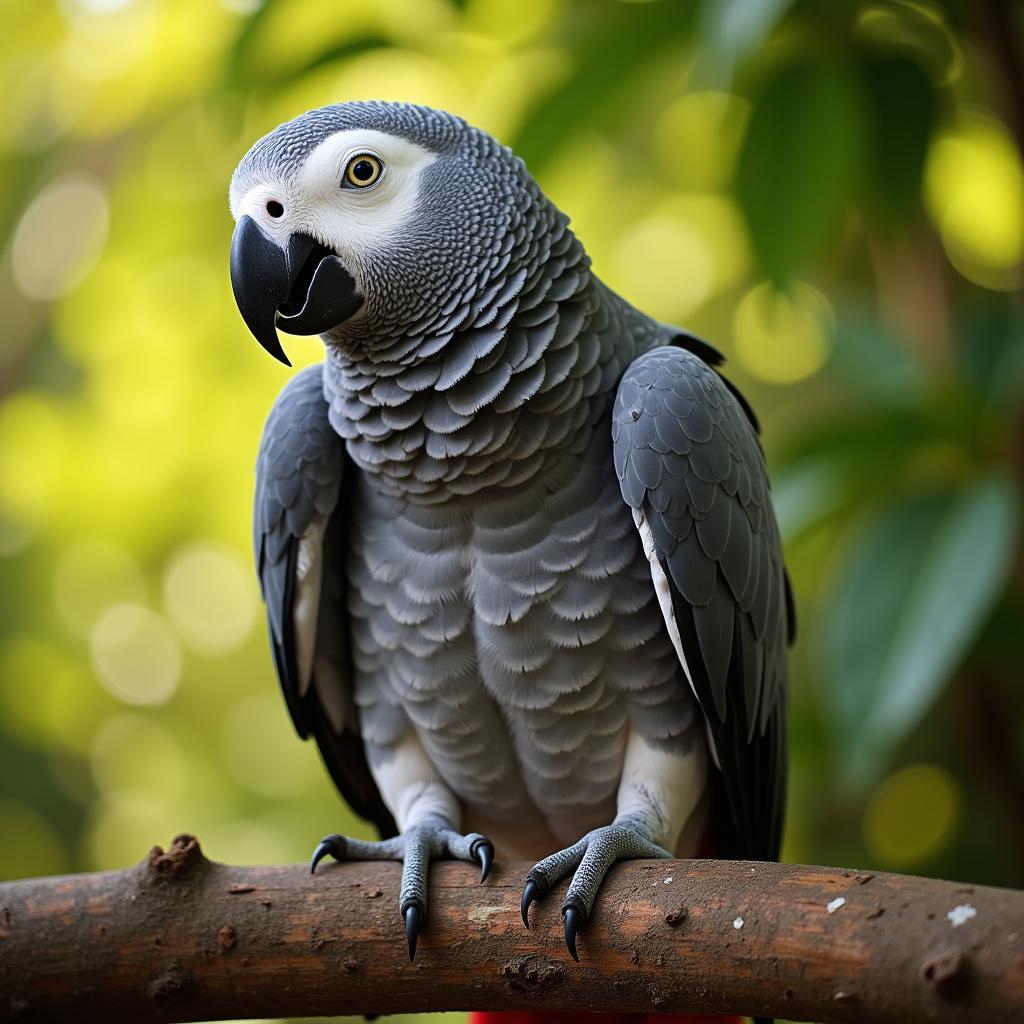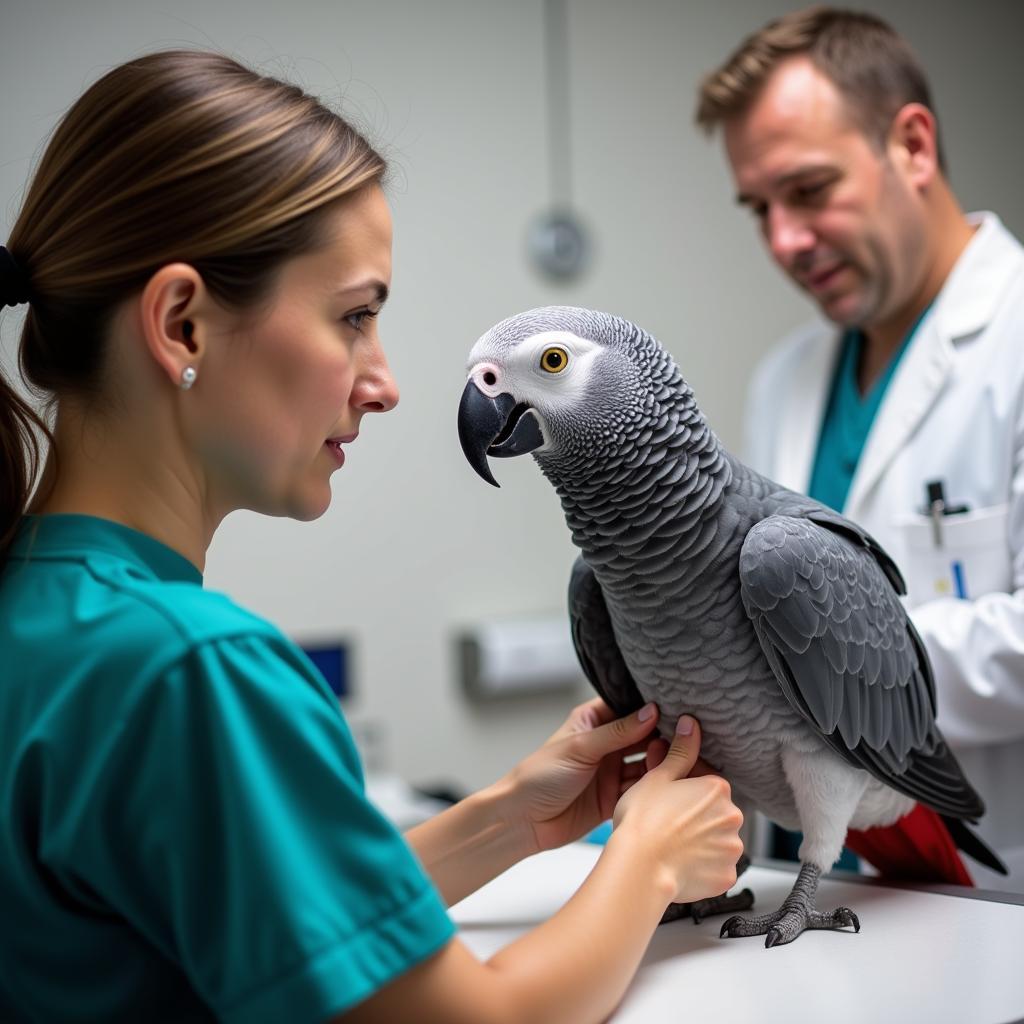Can African Grey Parrots Tolerate Cold Weather?
African grey parrots, known for their exceptional intelligence and talking abilities, are native to the warm, humid forests of Central and West Africa. Their natural habitat has inevitably led many to wonder: can African grey parrots tolerate cold weather? The short answer is no. These parrots thrive in temperatures significantly warmer than those typically experienced in temperate regions.
Understanding an African Grey Parrot’s Temperature Needs
 African grey parrot perched on a branch, enjoying the warmth of the sun
African grey parrot perched on a branch, enjoying the warmth of the sun
African grey parrots are most comfortable in temperatures ranging from 75 to 85 degrees Fahrenheit (24-29 degrees Celsius). This range mirrors the consistently warm climate of their native habitats. Exposing an African grey parrot to temperatures below 65 degrees Fahrenheit (18 degrees Celsius) can lead to serious health problems.
Why Cold is Dangerous for African Grey Parrots
Unlike some bird species that can adjust to varying temperatures, African grey parrots are particularly vulnerable to cold stress. Their bodies are not equipped to handle drastic temperature drops.
- Hypothermia: Just like humans, African grey parrots can suffer from hypothermia when exposed to cold. Hypothermia sets in when the body temperature drops below normal, impairing bodily functions.
- Respiratory Infections: Cold temperatures can weaken an African grey parrot’s immune system, making them susceptible to respiratory infections. Signs of a respiratory infection include wheezing, discharge from the nostrils, and labored breathing.
Protecting Your African Grey Parrot from the Cold
 An owner carefully covers their parrot's cage with a blanket as night falls.
An owner carefully covers their parrot's cage with a blanket as night falls.
Providing a warm, comfortable environment is crucial to an African grey parrot’s well-being, especially during colder months. Here are some essential tips:
- Maintain a Consistent Room Temperature: Ensure the room where your parrot spends most of their time stays consistently warm. Use a room thermometer to monitor the temperature and consider using a space heater if necessary, but always keep safety in mind by placing it away from flammable objects and the cage itself.
- Provide a Warm and Cozy Sleep Environment: Place a warm, fleece-lined bed inside your parrot’s cage. You can also cover the cage partially with a blanket at night to retain heat, making sure there is adequate ventilation.
- Avoid Drafts: Keep your parrot’s cage away from drafty windows, doors, and air conditioning vents. Even a slight draft can significantly impact their body temperature.
- Offer Warm Food and Water: Consider warming up their food and water slightly during colder periods. This will make it more appealing and comfortable for your parrot to consume.
Recognizing Signs of Cold Stress in Your Parrot
 A veterinarian gently examines an African grey parrot, checking for any signs of illness.
A veterinarian gently examines an African grey parrot, checking for any signs of illness.
It’s vital to be aware of the signs that indicate your African grey parrot might be struggling in the cold. These signs include:
- Fluffed Feathers: One of the first signs of cold stress is fluffed feathers. Parrots fluff their feathers to trap heat and stay warm.
- Shivering: Just like humans, parrots shiver when they are cold. If you notice your parrot shivering, it’s crucial to warm them up immediately.
- Lethargy and Loss of Appetite: If your typically active parrot becomes lethargic, quiet, and uninterested in food, it could be a sign of cold stress or a related illness.
If you notice any of these signs, consult an avian veterinarian immediately. Early detection and intervention are crucial for the health and well-being of your parrot.
In Conclusion
While African grey parrots bring joy and companionship to our lives, it’s essential to remember they are adapted to a specific climate. By understanding their needs and taking proactive steps to provide a warm, comfortable environment, you can help your feathered friend live a long, healthy, and happy life.

